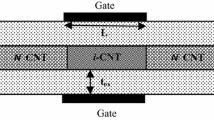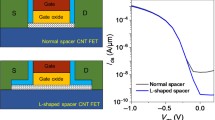Abstract
In the recent past, due to ballistic transport capability, carbon nanotube field-effect transistors (CNTFETs) have emerged as a potential replacement to conventional semiconductor devices. However, the major bottleneck issue of appropriate CNT synthesis is still standing high, and the fabrication of CNTFETs is usually found possible with Ohmic or Schottky type contacts. This paper concentrates on Schottky barrier(SB) CNTFETs in which carriers’ transmission coefficient is modulated at metal-CNT contact. The basic nature of metal contacted CNTFET devices is ambipolar, and it has been widely proved with the use of coupled Schrödinger–Poisson equation. However, it restricts the efficiency of CNTFETs in both active and cutoff regimes. This paper demonstrates the use of double-gate (DG) structure in CNTFETs to suppress ambipolarity in an efficient way. We have explicitly used the ant lion optimization technique to optimize Ion and Ioff current and established that the proposed enhanced-gate overlapping approach improves the performance characteristic of the CNTFETs.
Similar content being viewed by others
Availability of data and materials
It is not applicable for this manuscript.
References
Heinze S, Tersoff J, Martel R, Derycke V, Appenzeller J, Avouris P h (2002) Carbon nanotubes as schottky barrier transistors. Phys Rev Lett 89(10):106801
Guo J, Datta S, Lundstrom M (2004) A numerical study of scaling issues for schottky-barrier carbon nanotube transistors. IEEE Trans Electron Dev 51(2):172–177
Jooq MKQ, Mir A, Mirzakuchaki S, Farmani A (2020) Design and performance analysis of wrap-gate cntfet-based ring oscillators for iot applications. Integration 70:116–125
Samal A, Tripathi SL, Mohapatra SK (2020) A journey from bulk mosfet to 3 nm and beyond. Transactions on Electrical and Electronic Materials, 1–13
Vandana B, Kumar DJ, Mohapatra SK, Lata TS (2018) Impact of channel engineering (si1-0.25 ge0 25) technique on gm (transconductance) and its higher order derivatives of 3d conventional and wavy junctionless finfets (jlt). Facta Universitatis-Series: Electronics and Energetics 31(2):257–265
Luqi T, Danyang W, Song J, Ying L, Qianyi X, He T, Ningqin D, Xuefeng W, Yi Y, Tian-Ling R (2016) Fabrication techniques and applications of flexible graphene-based electronic devices. J Semicond 37(4):041001
H Liu H Y u (2019) Ionic liquids for electrochemical energy storage devices applications. J Materials Sci Technol 35(4):674–686
Jogad S, Loan SA, Afzal N, Alharbi AG (2021) Cntfet based class ab current conveyor ii: design, analysis and waveform generator applications. Int J Numer Modell: Electron Netw Dev Fields 34(1):e2783
Rani S, Singh B (2021) Cntfet based 4-trit hybrid ternary adder-subtractor for low power & high-speed applications. Silicon, 1–14
Ramos-Silva JN, Pacheco-Sanchez A, Diaz-Albarran LM, Rodriguez-Mendez LM, Enciso-Aguilar MA, Schröter M, Ramírez-García E (2020) High-frequency performance study of cntfet-based amplifiers. IEEE Trans Nanotechnol 19:284–291
Lyubutin PS, Burkov MV, Eremin AV (2020) Evaluation of elastic modulus of carbon fiber reinforced polymers using an optical extensometer. J Phys: Conf Series 1611:012019. IOP Publishing
Wang Z, Shan X, Cui X, Tian P (2020) Characteristics and techniques of gan-based micro-leds for application in next-generation display. J Semicond 41(4):041606
Cheng R, Chen Z, Yuan S, Takenaka M, Takagi S, Han G, Zhang R (2021) Mobility enhancement techniques for ge and gesn mosfets. J Semicond 42(2):023101
Liao F, Wang H, Guo X, Guo Z, Tong L, Riaud A, Sheng Y, Chen L, Sun Q, Zhou P et al (2020) Charge transport and quantum confinement in mos2 dual-gated transistors. J Semicond 41(7):072904
Mendiratta N, Tripathi SL (2020) A review on performance comparison of advanced mosfet structures below 45 nm technology node. J Semicond 41(6):061401
Radosavljević M, Appenzeller J, Avouris P h, Knoch J (2004) High performance of potassium n-doped carbon nanotube field-effect transistors. Appl Phys Lett 84(18):3693–3695
Kim BM, Brintlinger T, Cobas E, Fuhrer MS, Zheng H, Yu Z, Droopad R, Ramdani J, Eisenbeiser K (2004) High-performance carbon nanotube transistors on srtio 3/si substrates. Appl Phys Lett 84(11):1946–1948
Javey A, Guo J, Wang Q, Lundstrom M, Dai H (2003) Ballistic carbon nanotube field-effect transistors. Nature 424(6949):654–657
Martel R, Derycke V, Lavoie C, Appenzeller J, Chan KK, Tersoff J, Avouris P h (2001) Ambipolar electrical transport in semiconducting single-wall carbon nanotubes. Phys Rev Lett 87(25):256805
Heinze S, Tersoff J, Avouris P h (2003) Electrostatic engineering of nanotube transistors for improved performance. Appl Phys Lett 83(24):5038–5040
Kumar A, Srivastava S, Saxena S, Tripathi SL (2020) (ba/pb) x sr 1- x tio 3 based capacitive sensor with lanio 3 electrode for higher tunability. J Mater Sci: Mater Electron 31(22):20387–20399
John DL, Castro LC, Pereira PJS, Pulfrey DL (2004) A schrödinger-poisson solver for modeling carbon nanotube fets. In: Proc. NSTI Nanotech, vol 3, pp 65–68
Appenzeller J, Radosavljević M, Knoch J, Avouris P h (2004) Tunneling versus thermionic emission in one-dimensional semiconductors. Phys Rev Lett 92(4):048301
Léonard F, Tersoff J (2002) Dielectric response of semiconducting carbon nanotubes. Appl Phys Lett 81(25):4835– 4837
Datta S (1997) Electronic transport in mesoscopic systems. Cambridge University Press
MINIMOS-NT Iμ E (2004) 2.1 user’s guide, Institut Für Mikroelektronik, Technische Universität Wien, Austria
Ungersbock E, Gehring A, Kosina H, Selberherr S, Cheong B-H, Choi WB (2003) Simulation of carrier transport in carbon nanotube field effect transistors. In: ESSDERC’03. 33rd conference on European solid-state device research, 2003. IEEE, pp 411–414
Radosavljević M, Heinze S, Tersoff J, Avouris P h (2003) Drain voltage scaling in carbon nanotube transistors. Appl Phys Lett 83(12):2435–2437
Clifford J, John DL, Pulfrey DL (2003) Bipolar conduction and drain-induced barrier thinning in carbon nanotube fets. IEEE Trans Nanotechnol 2(3):181–185
Assiri AS, Hussien AG, Amin M (2020) Ant lion optimization: variants, hybrids, and applications. IEEE Access 8:77746– 77764
Pourfath M, Ungersboeck E, Gehring A, Cheong B -H, Park W -J, Kosina H, Selberherr S (2005) Optimization of Schottky barrier carbon nanotube field effect transistors. Microelectron Eng 81(2-4):428–433
Lee JU, Gipp PP, Heller CM (2004) Carbon nanotube p-n junction diodes. Appl Phys Lett 85(1):145–147
Kumar G, Agrawal S (2021) Ant lion optimizer for suppression of ambipolar conduction in Schottky barrier carbon nanotube field effect transistors. Silicon, 1–9
Acknowledgements
It is not applicable for this manuscript.
Funding
The authors did not receive support from any organization for the submitted work. No financial support from any institution or authors.
Author information
Authors and Affiliations
Contributions
Both the authors have equal contributions in formulating the problems and getting the solution.
Corresponding author
Ethics declarations
Ethics approval and consent to participate
It is not applicable for this manuscript.
Research involving Human Participants and Animals
It is not applicable for this manuscript. No research involving animals. No research involving humans as subjects.
Consent for Publication
It is not applicable for this manuscript.
Competing interests
The authors declare that they have no competing interests.
Conflict of Interests
It is not applicable for this manuscript. No conflicts of interest.
Additional information
Publisher’s Note
Springer Nature remains neutral with regard to jurisdictional claims in published maps and institutional affiliations.
Rights and permissions
About this article
Cite this article
Kumar, G., Agrawal, S. Suppression of Ambipolar Current in Enhanced Gate Based Schottky Barrier CNTFET Using Ant Lion Optimization. Silicon 14, 11531–11537 (2022). https://doi.org/10.1007/s12633-022-01807-3
Received:
Accepted:
Published:
Issue Date:
DOI: https://doi.org/10.1007/s12633-022-01807-3




